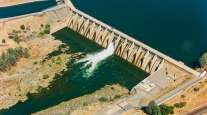CQ-Roll Call
Is Trump's Private-Investment Push Enough to Fix Infrastructure?

WASHINGTON — President Donald Trump's trip to Cincinnati on June 7 to highlight the nation's infrastructure needs echoes President Barack Obama's 2011 visit to the city's Brent Spence Bridge.
But the similarity ends at the photo op.
While both used the city to highlight the nation's vast infrastructure needs — Obama the bridge and Trump, focusing on inland waterways — how they would pay to meet those needs is vastly different.
Obama would have funded his infrastructure plan with an injection of federal dollars. Trump — whose plan is still being formulated but who campaigned on the promise of a $1 trillion infusion — would rely far more on private investment.
According to his budget, he'd invest $200 billion over 10 years in the nation's roads, bridges, airports and inland waterways. His plan to privatize the nation's air traffic control, announced June 5, is an example of how he might approach efforts to rebuild the nation: emphasizing private funding over federal funding.
By leveraging private investment, relying on state and city taxes and divesting from some transportation functions, his administration says he can do more with less tax revenue.
RELATED: Trump’s public-private infrastructure vision rejected in Texas
It is an idea that some say could work in a small setting but that may be harder on a broader scale.
"This is not a magical silver bullet that will solve all of our infrastructure problems," said Steve Davis of Transportation for America, an alliance devoted to improved transportation policy.
"You can't have a toll booth lined up at every intersection," said Chris Runyan of the Ohio Contractors Association. "Yes, it has a place, but is it going to be a solve-all for a $1 trillion program? No."
Runyan said that while privatization has worked in some cases — he called Gov. John Kasich's turnpike bond leveraging relatively successful — there's simply no way it can be done on many city roads and rural highways. While it might be a good answer for lane additions or bridges, "I don't think privatization is the tool necessarily to do the baseline maintenance of our system."
"Without a revenue stream that goes back to the investors, who wants to invest in that?" he asked.
RELATED: Rep. Shuster on infrastructure funding debate: ‘not interested in 2018’
The needs are vast. According to the American Society of Civil Engineers, driving on roads in need of repair in Ohio costs each driver $475 per year, and 6.9% of the state's bridges are considered structurally deficient. Drinking water needs in Ohio will cost an estimated $12.2 billion, and wastewater needs total $14.58 billion. And 362 dams are considered to have high hazard potential.
Matt Bruning, a spokesman for the Ohio Department of Transportation, said the state has been creative in generating money for roads and bridges.
"By finding efficiencies, leveraging the Ohio Turnpike and using other innovative sources of funding, we've been able to put an unprecedented $14 billion to work on nearly 7,000 projects to improve travel in our state" since Kasich took office, Bruning said.
Infrastructure is one of those rare political issues that everyone can agree on: build or improve roads and bridges, and economic improvements follow, through building the roads and through easing commercial activity.
"It doesn't matter who you are — whether you are farmer in the Midwest, or a mother driving your kids to and from school or a worker or a college kid flying back and forth to school — you're affected by infrastructure," White House economic adviser Gary Cohn said in a conference call with reporters.
He said the nation was "falling behind, and falling behind is affecting economic growth in the United States. The president wants to fix the problems, and he doesn't want to push these liabilities into the future."
But Casey Dinges, senior managing director of public affairs for the American Society of Civil Engineers, said that taxpayers ultimately pay for infrastructure.
"You can pay taxes or tolls," he said. "When people think privatization or public-private partnerships, they think it's free or easy money coming from somewhere. That's not the case. You're going to pay either way."
But there are some advantages to privatization, too, Dinges acknowledged. "Things can move a little faster if you've got a private entity involved."
For decades, the federal government has paid for infrastructure improvement through the Highway Trust Fund — a pot of money paid for through the federal gasoline tax, which, at 18.4 cents a gallon, has not increased since President Bill Clinton's first term.
During the Obama administration, Democrats called for repatriating corporate profits made overseas to pay for infrastructure. Congress ultimately paid for the latest highway bill with a series of budget gimmicks.
And in the meantime, at least 22 states have increased their own gasoline taxes since 2013. Ohio last increased its gas tax in 2003.
Democrats, meanwhile, have pushed for far more federal dollars than Trump is considering, with the Progressive Caucus suggesting $2 trillion in infrastructure investment over 10 years.
Davis, of Transportation for America, said Trump's campaign promises to invest in infrastructure "have just been continually downgraded."
"At the heart of this plan is the plan to require states and localities that are already cash-strapped and facing difficult budget circumstances to shoulder more of the burden in order to reduce federal investment into infrastructure," he said. "That is not a $1 trillion infrastructure plan."




